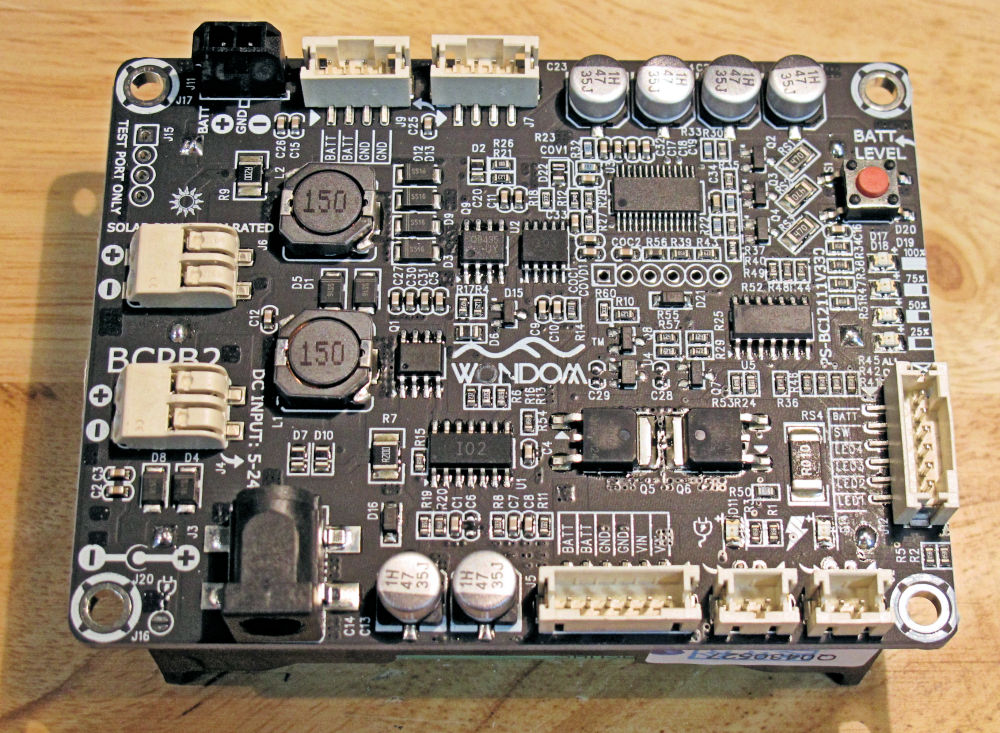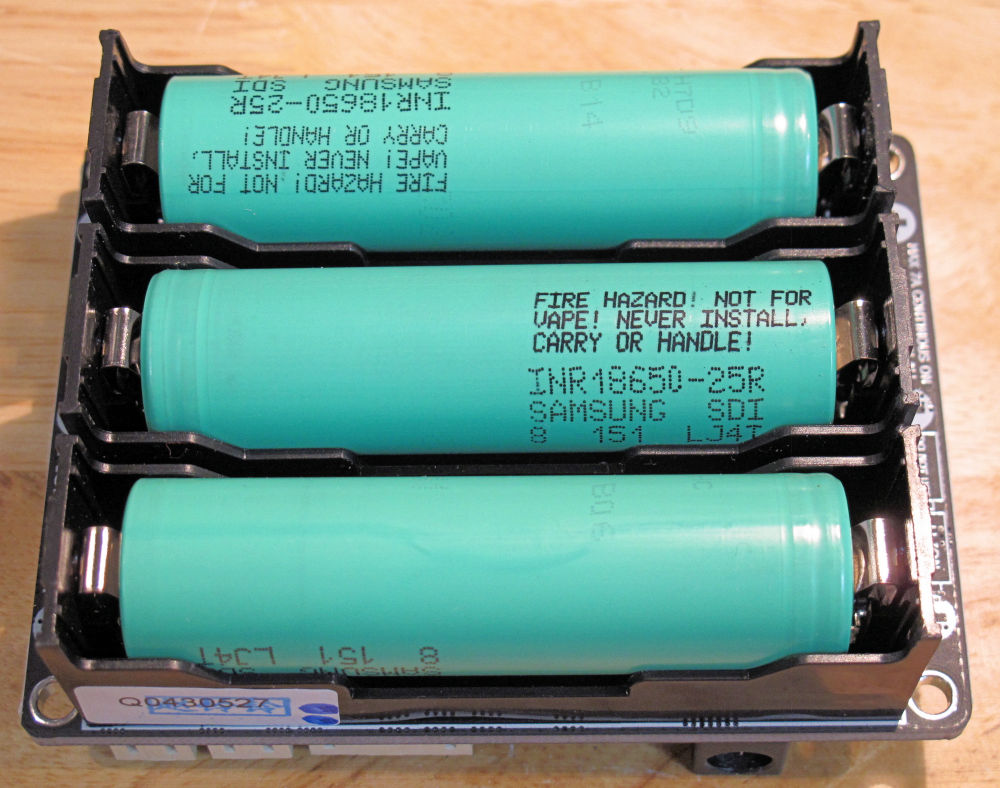This article isn’t about a new product. It’s just new to me. The product is Wondom’s BCPB2, a charger, battery management system (BMS), and battery holder for three 18650 lithium-ion cells. I discovered this product while considering ways to repair the battery subsystem in a Keithley 197 Microvoltmeter made around 1991 that I recently bought on eBay. The original battery in this 30-year-old product is a 12V pack made from NiCd cells. That pack took one charge and then died, so I disconnected the battery pack but left the charging board in place. The microvoltmeter works fine on ac line power even with the pack disconnected. I’m surprised the pack worked at all after three decades.
I did not want to replace the existing NiCd pack with batteries of the same chemistry, even though that would have been the simplest route. I don’t think NiCd packs are the best choice any longer. I’d prefer to use Lithium-ion, Lithium-polymer, or Lithium-Iron-Phosphate (LiFePO4) cells. However, the Keithley 197’s original charging circuit is not suitable for lithium batteries because it runs a significant trickle charge through the internal battery pack while the instrument is plugged into the mains outlet. NiCd and NiMH batteries can tolerate a trickle charge, but most lithium cells can’t. As a result, I started to research ways to replace the Keithley 197’s entire charging subsystem, and that’s when I discovered the shockingly inexpensive BCPB2.
The Wondom BCPB2 is a circuit board UPS that measures 3.6 x 2.7 inches. It’s exactly large enough to accommodate three 18650 Lithium-ion cell holders on one side with just enough room left for four mounting holes on the board’s corners. The other side of the board sports ten connectors, several ICs and power FETs, assorted passive components, and a four-LED bar graph that shows the state of battery charge. In use, you provide a charging current from one of three connectors. A 5.5/2.1mm barrel jack and a 2-pin solderless Wago connector accept a charging source ranging from 5V to 24V, which means that there’s a boost/buck regulator connected to these inputs.
A second 2-pin Wago connector accepts power from a photovoltaic (PV) solar array and is connected to a charging circuit that implements Maximum Power Point Tracking (MPPT), an algorithm designed to extract the maximum available power from a PV module based on incident solar radiation, ambient temperature, and PV array temperature, although there doesn’t seem to be a way to bring temperatures onto the board. All three input connectors feed the board’s internal circuitry through diodes to prevent backflow current from one input port to another. In short, the BCPB2 accepts a wide range of power inputs for charging the three 18650 cells at a nominal 600mA. The board can also charge Lithium-polymer batteries, and it can supply battery power to external circuits while charging the on-board batteries.

The $12 Wondom BCPB2 UPS board accepts multiple charging inputs for its three 18650 Lithium-ion batteries and can supply battery power to external circuits while charging the on-board batteries. Image credit: Steve Leibson
The board incorporates a BMS for balancing the charge current among the three 18650 cells and for terminating the charge current if the cell voltage falls below a minimum cell voltage or rises above a maximum cell voltage. Lithium cells with too low of a voltage cannot be charged with conventional Lithium-ion charging algorithms, so the board will not charge cells that measure below about 2.8V. Charging cells that are already fully charged can produce spectacular fires, so the board will not charge cells that measure more than about 4.2V.

The Wondom BCPB2 board tightly grips three 18650 Lithium-ion batteries in holders soldered to the board’s back side. Image credit: Steve Leibson
The BCPB2 has three output connectors that are all connected to the series battery stack. One of the connectors is a 2-pin Molex Micro-Fit connector, and the other two connectors are 4-pin JST PH-2mm connectors. The Molex connector can supply as much as 6A of continuous output current with peaks of 12A for 200msec, and the JST connectors can each handle 4A continuously with 8A peaks for 200msec. These connectors are tied directly to the 3-cell battery array, so the output voltage is nominally 12V, but the actual output voltage will reflect the current state of charge for these batteries. Wondom supplies a short 4-wire cable with JST connectors on each end with the BCPB2 board. You can cut this cable in half to make two cables that plug into the board’s two JST output connectors.
A convenient on-board 4-LED bar graph driven by a simple voltage monitor displays an estimate of the state of battery charge. These LEDs glow continuously when the on-board batteries are charging and light up when you press the “Battery Level” switch if there’s no charging voltage present. The board’s on-board circuitry provides overcharge, overcurrent, and over-discharge protection for the batteries. Overcurrent protection doesn’t work if the battery is connected to a load.
Several other on-board JST connectors provide a means to connect remote LED indicators for displaying the presence of external power and the batteries’ charging/charged status and to replicate the board’s 4-LED state-of-charge bar graph on a front panel. The 6-pin JST connector for the bar graph LEDs also has a pair of pins for an external pushbutton to activate the bar graph.
The BCPB2 board is designed to operate as a true UPS with separate and independent connections for charging and output power. This 2-port design is at odds with the usual sort of battery backup built into instruments designed for mains and battery operation. My Keithly 197 microvoltmeter and my HP 5314A frequency counter, both designed around 1980, incorporate optional NiCd packs with a single pair of pins for charge and discharge. These NiCd packs are integrated into the power supply design so that they charge whenever the instrument is plugged into a wall outlet, regardless of the state of the on/off switch.
These NiCd packs deliver power when the instrument is switched on, but the power cord is not delivering power from a wall outlet. Diodes in the instruments’ power supplies ensure that current flows the right way. With its separate charge and discharge ports, the BCPB2 board is not compatible with this scheme, so if I were designing it into either of these two instruments today, I’d likely bypass the ac power supplies and provide a separate dc charging port on a back panel. The BCPB2 will operate with input voltages as low as 5V, so you could use a USB wall charger as a power supply.
I could retrofit the Keithley 197 with a back-panel dc connector, but ultimately, I decided to leave the Keithley 197 as a corded instrument. It’s too large and bulky to use as a cordless meter, and I’ve got better alternatives. Nevertheless, I think that a UPS board like the BCPB2 with all these features that costs less than $12 in single quantities, with $8 for shipping, is a pretty amazing deal and could easily fit into new designs.
However, as nice as the BCPB2 board is, the instructions consist of a minimalistic 4-page information sheet that you can find on Wondom’s Website (sure-electronics.com). There does not seem to be additional documentation available. Most of the board’s features are only briefly described on the information sheet, and the English is clearly translated from Chinese. For example, when I first loaded the three 18650 cells into the holders on the board, the LED bar graph did not light up. Careful reading of the information sheet suggested that the board would not operate until a voltage was applied to one of the charging connectors after fresh batteries were installed. I found this out through trial and error after installing fresh Samsung 18650 cells from the 18650BatteryStore.com. The LED bar graph refused to light until I applied some power to a charging connector.
A description of this behavior does appear on the information sheet as a light gray footnote beneath a block diagram – “A power supply must be plugged-in [sic] for the BCPB2 to have a power output after installing or reinstalling batteries” and as Note 4 at the bottom of the information sheet’s first page: “If the board goes into a protection mode or the battery has been reinstalled, please recharge the board with the DC Input Jack to reactivate.”
If you’ve never heard of Wondom, I’m not surprised, because I’d never heard of them either. Their main product line appears to be Class D audio amplifier boards, and their battery-charging and UPS products seem to be aimed mostly at supporting the company’s audio boards to create cordless Bluetooth amplifiers and speaker systems. (“Wondom” is apparently a contraction of “Wonderful Meeting With Melody” based on text printed on the BCPB2’s box.) You can find the BCPB2 board on Wondom’s Web site and on Amazon, eBay, and Alibaba. Just search for “BCPB2.” In single unit quantities, the board’s price varies from $10 to $16, and the shipping cost varies from $4 to $8, so the total cost for one board is consistently under $20 wherever you make the purchase. You can also get a complete BCPB2 cable kit for about $2 from Wondom, with $8 shipping.
All in all, I think the BCPB2 is a well-designed product. The manufacturing quality seems excellent. I showed the board to my friend Ron Sartore. His company, Altimeter Motives, makes aircraft control panels for hobby-level flight simulation systems based on Microsoft Flight Simulator and X-Plane. Ron summarized the board nicely: “I don’t know what I’d use it for, but I want one.”






Wondom has been the name that Sure Electronics has used for the last number of years that collects most of their audio-focused products, most of which are Bluetooth receiver+amplifier boards.
Sure has been around for decades, and like Futurlec, kinda was SparkFun/Adafruit before the whole maker/faker craze in electronics got rolling 10-15 years ago. They used to deal mostly in component breakout boards, MCU (esp. PIC) clone programmers, and all their related accessories.
For many, many years Sure was reasonably well regarded but was famous for all of their boards having serious post-nasal drip issues — that is, they VERY clearly were never cleaned after manufacture. Those who knew better would clean them upon receipt before they had the chance to get grimmy.
Sure seemed to be on top of that market segment’s heap back in those PICKit1 days, before Arduino and the first MSP430F100x USB stick reset and blew open the pre-professional MCU market .
Hi ericwertz. Based on my sample of one board, I’d have to say that Wondom has mastered board cleaning.